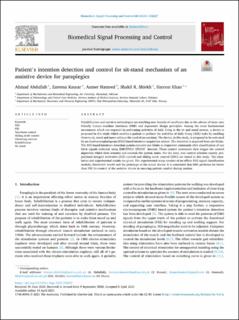Patient's intention detection and control for sit-stand mechanism of an assistive device for paraplegics
Peer reviewed, Journal article
Published version
Permanent lenke
https://hdl.handle.net/11250/2779062Utgivelsesdato
2021-04-19Metadata
Vis full innførselSamlinger
Originalversjon
https://doi.org/10.1016/j.bspc.2021.102627Sammendrag
Rehabilitation and assistive technologies are touching new bounds of excellence due to the advent of more user friendly human–machine interfaces (HMI) and ergonomic design principles. Among the most fundamental movements which are required in performing activities of daily living is the sit and stand motion, a device is proposed in this study which enables a patient to perform his activities of daily living (ADL) tasks by enabling them to sit, stand and move without the need of an assistant. The device, in this study, is proposed to be activated by an electroencephalogram (EEG) based intention acquisition system. The intention is acquired from eye blinks. The EEG based intention detection system converts eye blinks to respective commands after classification of eye blink signals collected using EMOTIVE® EPOCH+ headset. These control commands then trigger the control algorithm which then actuates and controls the system states. For the later, two control schemes namely proportional integral derivative (PID) control and sliding mode control (SMC) are tested in this study. The simulation and experimental results are given. The experimental setup consists of an offline EEG signal classification module, Simulink® model and the prototype of the actual device. It is concluded that SMC performs far better than PID for control of the assistive device in ensuring patient comfort during motion.

